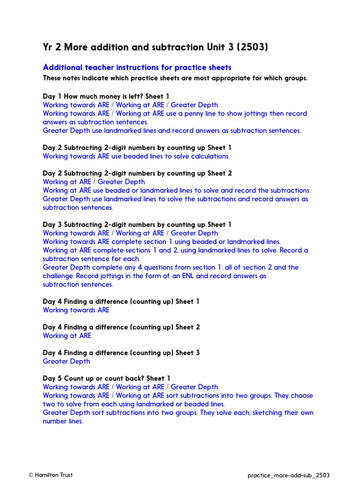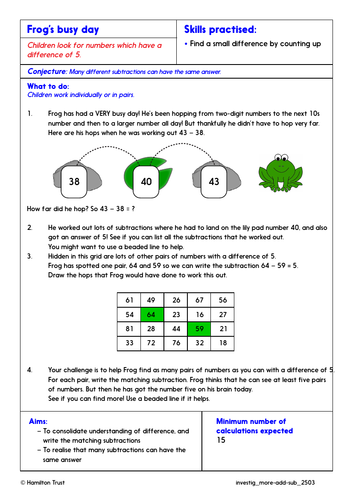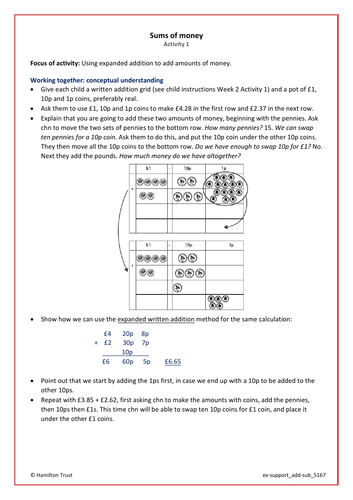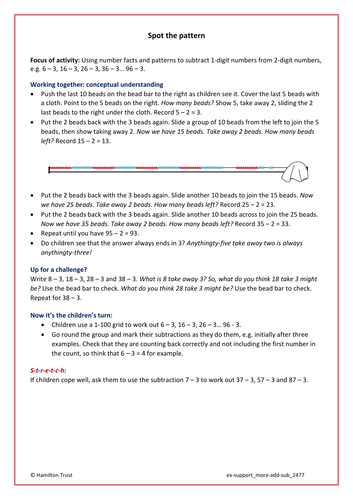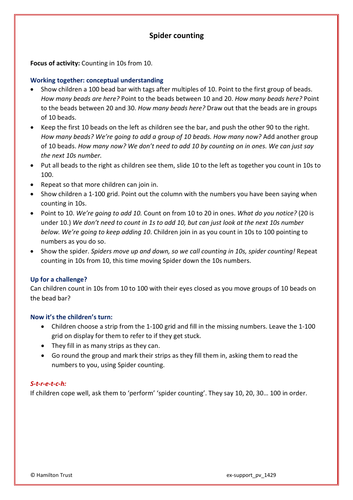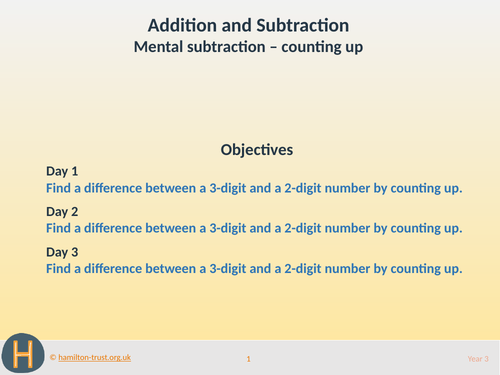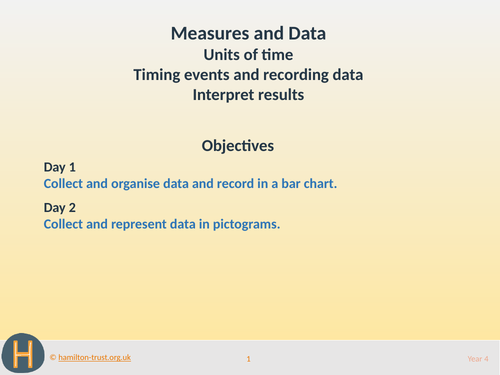
397Uploads
10014k+Views
11624k+Downloads
Mathematics

Problem-Solving Investigation: Decimal and money calculation. (Year 5 Addition and Subtraction)
Year 5 Addition and Subtraction: Decimal and money calculation.
This in-depth Maths Investigation will develop maths meta-skills, and enable children to learn to think mathematically and articulate mathematical ideas.
In-depth Investigation: Adding Odd and Even Amounts
Children create two amounts of money – one with even digits, one with odd digits – and add these. They look for patterns of even/odd in the totals.
This problem-solving investigation is part of our Year 5 Addition and Subtraction block. Each Hamilton maths block contains a complete set of planning and resources to teach a terms worth of objectives for one of the National Curriculum for England’s maths areas.

Subtraction with decimals, e.g. money - Problem-Solving Investigation - Year 5
This in-depth maths investigation is an open-ended problem solving activity for Year 5 children. It can be used to support teaching towards the objective subtraction with decimals including money.
In-depth Investigation: Decimal Differences
Children subtract pairs of numbers with consecutive digits and different numbers of decimal places, and look for patterns in their answers.
This investigation will develop maths meta-skills, support open-ended questioning and logical reasoning, and enable children to learn to think mathematically and articulate mathematical ideas.
This problem-solving investigation is part of our Year 5 Decimals and Fractions block. Each Hamilton maths block contains a complete set of planning and resources to teach a term’s worth of objectives for one of the National Curriculum for England’s maths areas.

Expanded & compact column subtraction - Extra Support Activity -Year 4
This activity is designed to be used by a teacher or a TA with children who need extra support before they can tackle these objectives: Use expanded and compact column subtraction with numbers <1000
Hops to 100 and Beyond - Using counting up (Frog) to subtract numbers either side of a multiple of 100, e.g. 304 – 297, then 304 – 267
This Extra Support Activity is part of our Year 4 Decimals and Fractions block. Each Hamilton maths block contains a complete set of planning and resources to teach a term’s worth of objectives for one of the National Curriculum for England’s maths areas.

Begin to understand percentages - Practice Worksheets & Answers - Year 5
Year 5 Decimals, Percentages, Fractions: Begin to understand percentages.
Procedural fluency practice worksheets to achieve maths mastery. Differentiated for children working towards Age Related Expectations (ARE), at ARE and at greater depth. Includes answers.
Day 1 - Write the percentage of each 100-square that is shaded, then an equivalent vulgar and decimal fraction.
Day 2 - Convert fractions to percentages.
Day 3 - Find percentages of amounts: multiples of 100.
Find percentages of amounts: multiples of 10 and 100.
These procedural fluency practice sheets are part of our Year 4 Decimals and Fractions block. Each Hamilton maths block contains a complete set of planning and resources to teach a term’s worth of objectives for one of the National Curriculum for England’s maths areas.

Practice Worksheets: Subtract by counting up. ( Year 2 More Addition and Subtraction )
Year 2 More Addition and Subtraction: Subtract 2-digit numbers by counting up; choose a strategy.
Procedural fluency practice worksheets to achieve maths mastery. Differentiated for children working towards Age Related Expectations (ARE), at ARE and at greater depth.
Day 1 - Find how much money is left over when children buy a drink by finding the difference.
Day 2 - Use Frog (counting up) to solve subtractions.
Day 3 - Subtract 2-digit numbers by counting up.
Day 4 - Use number lines to find the difference by counting up.
Day 5 - Choose an efficient strategy to solve subtractions.
These procedural fluency practice sheets are part of our Year 2 More Addition and Subtraction block. Each Hamilton maths block contains a complete set of planning and resources to teach a terms worth of objectives for one of the National Curriculum for England’s maths areas.

Problem-Solving Investigation: Subtract by counting up. ( Year 2 More Addition and Subtraction )
Year 2 More Addition and Subtraction: Subtract 2-digit numbers by counting up; choose a strategy.
This in-depth Maths Investigation will develop maths meta-skills, and enable children to learn to think mathematically and articulate mathematical ideas.
In-depth Investigation: Frog’s Busy Day
Children look for numbers which have a difference of 5 using Frog to help.
This problem-solving investigation is part of our Year 2 More Addition and Subtraction block. Each Hamilton maths block contains a complete set of planning and resources to teach a terms worth of objectives for one of the National Curriculum for England’s maths areas.

Extra Support Activity: Decimal and money calculation. (Year 5 Addition and Subtraction)
This activity is designed to be used by a teacher or a TA with children who need extra support before they can tackle these National Curriculum objectives: Decimal and money calculation.
Sums of Money - Using expanded addition to add amounts of money
DVD Decisions - Using counting up (Frog) to calculate change from £10
This Extra Support Activity is part of our Year 5 Addition and Subtraction block. Each Hamilton maths block contains a complete set of planning and resources to teach a terms worth of objectives for one of the National Curriculum for England’s maths areas.

Extra Support Activity:Column subtraction; choose strategies. (Year 5 Addition and Subtraction)
This activity is designed to be used by a teacher or a TA with children who need extra support before they can tackle these National Curriculum objectives: Column subtraction, and choosing a method.
Frog’s Ginormous Jumps - Using counting up (Frog) to subtract 3-digit numbers.
This Extra Support Activity is part of our Year 5 Addition and Subtraction block. Each Hamilton maths block contains a complete set of planning and resources to teach a terms worth of objectives for one of the National Curriculum for England’s maths areas.

Practice Worksheets: Properties of numbers, e.g. odd/even. (Year 2 Place Value and Fractions )
Year 2 Place Value and Fractions: Properties of numbers including odd/even.
Procedural fluency practice Worksheets to achieve maths mastery. Differentiated for children working towards Age Related Expectations (ARE), at ARE and at greater depth.
Day 1 - Make odd and even numbers from a range of given digits.
Day 2 - Sort numbers into ‘sorting machines’ according to given criteria.
These procedural fluency practice sheets are part of our Year 2 Place Value and Fractions block. Each Hamilton maths block contains a complete set of planning and resources to teach a terms worth of objectives for one of the National Curriculum for England’s maths areas.

Extra Support Activity: Subtract by counting back. ( Year 2 More Addition and Subtraction )
This activity is designed to be used by a teacher or a TA with children who need extra support before they can tackle these objectives: Subtract 2-digit numbers by counting back.
Spot the Pattern - Using number facts and patterns to subtract 1-digit numbers from 2-digit numbers, e.g. 6 - 3, 16 - 3, 26 - 3, 36 - 3… 96 - 3
This Extra Support Activity is part of our Year 2 More Addition and Subtraction block. Each Hamilton maths block contains a complete set of planning and resources to teach a terms worth of objectives for one of the National Curriculum for England’s maths areas.

Extra Support Activity: Count in 10s; say numbers 10 more/less. ( Year 1 Place Value )
This activity is designed to be used by a teacher or a TA with children who need extra support before they can tackle these objectives: Count in 10s and say numbers 10 more and 10 less.
Spider Counting - Counting in 10s from 10.
This Extra Support Activity is part of our Year 1 Place Value block. Each Hamilton maths block contains a complete set of planning and resources to teach a term’s worth of objectives for one of the National Curriculum for England’s maths areas.

Extra Support Activity: Properties of numbers including odd/even (Year 2 Place Value and Fractions)
This activity is designed to be used by a teacher or a TA with children who need extra support before they can tackle these objectives: Properties of numbers including odd/even.
Blues and Twos - Counting in 2s from 1 and from 2
This Extra Support Activity is part of our Year 2 Place Value and Fractions block. Each Hamilton maths block contains a complete set of planning and resources to teach a terms worth of objectives for one of the National Curriculum for England’s maths areas.

Extra Support Activity: Subtract by counting up. ( Year 2 More Addition and Subtraction )
This activity is designed to be used by a teacher or a TA with children who need extra support before they can tackle these objectives: Subtract 2-digit numbers by counting up; choose a strategy.
Tall Towers - Finding a small difference.
This Extra Support Activity is part of our Year 2 More Addition and Subtraction block. Each Hamilton maths block contains a complete set of planning and resources to teach a terms worth of objectives for one of the National Curriculum for England’s maths areas.

Subtract larger numbers using counting up (frog) - Teaching Presentation - Year 3
This presentation provides five days of teaching that cover the objectives:
• Revise placing 2-digit numbers on lines
• Place 3-digit numbers on lines
It includes starter activities, whole class teaching, group activities, practice sheets and mastery questions. It can be used on a variety of interactive whiteboards.
Although column subtraction is specified for Year 3 in the National Curriculum, Hamilton believe that teaching column subtraction in Year 4 will be more successful. The National Curriculum Guidance specifies that teachers can teach areas of study in different year groups than those mentioned in the Curriculum, so long as they are taught within the same Key Stage. If you would like to teach column subtraction in Year 3 please see Year 4 Addition and Subtraction autumn Unit 7, spring Unit 4 and summer Units 2 and 3.
Day 1 Teaching
Write 137 – 72. Agree we can use Frog to find this difference, by, counting up from 72 to 137. Draw an empty number line jotting to show this and model each of Frog’s jumps (72 to 80, 80 to 100 and 100 to 137). Explain that we can do 1 big jump to 100. Repeat to model using Frog to do £1.46 – 83p. Children try £1.23 – 88p.
Day 2 Teaching
Display a word problem resulting in the calculation 476 – 438. How can Maths Frog help us to work this out? Frog will start on 438, jump to the next 10 (440), then jump to 470, then 476. Remind children that we could do one big jump of 36 from 440 to 476 if we are confident but we don’t have to! Children try 873 – 837.
Day 3 Teaching
Show a toy priced £4.67. Give a child a £5 note and ask them to use this to pay for the toy. You’ve given the shopkeeper too much money. How will she work out how much change to give you? Maths Frog can help us! Sketch a line from £4.67 to £5. Model using Frog to hop to £4.70 and then to £5. Repeat, to find change from £10 and £20.
Day 4 Teaching
Show a game and say that it costs £18. So far Katie has saved up £7.55. How much more does she need? Maths Frog can help! Sketch a line from £7.55 to £18. Model the hops from £7.55 to £7.60, then to £8, then to £18. Ensure children add hops accurately to find the answer: £10.45. Repeat as necessary for finding the difference between £8.43 and £14, then £6.55 and £19.
Day 5 Teaching
A family have £100 and so far have spent £67.73. How much money is left? Use Frog to model the hops. Ask children to add the jumps, adding the £s first then the pence, then put them together. Some children may draw 3 hops, others draw 4. It doesn’t matter as long as we get the right answer! Repeat for a family who have spent £62.41 out of their £100.
This teaching is part of Hamilton’s Year 5 Decimals and Fractions block. Each Hamilton maths block contains a complete set of planning and resources to teach a term’s worth of objectives for one of the National Curriculum for England’s maths areas.

Teaching Presentation: Using place value to add/subtract. ( Year 3 Addition and Subtraction )
This presentation provides five days of teaching that cover the objectives:
Using place value to add/subtract
It includes starter activities, whole class teaching, group activities, practice sheets and mastery questions. It can be used on a variety of interactive whiteboards.
Day 1 Teaching
Display a place value grid and write 3-digit numbers on it. Show which digit changes if you add multiples of 10. Repeat to show which digit changes if you add multiples of 100. Repeat for 1s.
Day 2 Teaching
Use a place value grid to show which digit changes if you subtract multiples of 10. Repeat for multiples of 100 or 1.
Day 3 Teaching
Demonstrate how to add and subtract near multiples of 10 to/from 2-digit numbers using a number line, and also a 1-100 number grid.
Day 4 Teaching
Use an empty number line to model the hops involved in adding a near multiple of 10 to a 3-digit number: 225 + 29 is 225 hop 30 along and then back 1, etc.
Day 5 Teaching
Use an empty number line to model the hops involved in subtracting a near multiple of 10 from a 3-digit number. Demonstrate how we adjust the hops to subtract 51 or 49 rather than 50.
This teaching is part of Hamilton’s Year 3 Place Addition and Subtraction block. Each Hamilton maths block contains a complete set of planning and resources to teach a term’s worth of objectives for one of the National Curriculum for England’s maths areas.

Teaching Presentation: Mental subtraction – counting up ( Year 3 Addition and Subtraction )
This presentation provides three days of teaching that cover the objectives:
Mental subtraction – counting up
It includes starter activities, whole class teaching, group activities, practice sheets and mastery questions. It can be used on a variety of interactive whiteboards.
Day 1 Teaching
Remind children of Maths Frog. Demonstrate how we can count up along an empty number line using Frog to work out the difference between 87 and 102. Model several subtractions.
Day 2 Teaching
Demonstrate counting up using Frog hopping along a number line to show how we calculate 113 – 78. Stress how we add the hops to find the answer.
Day 3 Teaching
Use Frog and the empty number line to perform subtractions (112 – 76) and make deliberate errors which children have to correct.
This teaching is part of Hamilton’s Year 3 Addition and Subtraction block. Each Hamilton maths block contains a complete set of planning and resources to teach a term’s worth of objectives for one of the National Curriculum for England’s maths areas.

Teaching Presentation: Rehearse 24 hour clock; time intervals ( Year 4 Measures and Data )
This presentation provides two days of teaching that cover the objectives:
Rehearse 24 hour clock
Time intervals
It includes starter activities, whole class teaching, group activities, practice sheets and mastery questions. It can be used on a variety of interactive whiteboards.
Day 1 Teaching
Revise 24-hr clock using a train timetable and relating times to the school day. Convert 24-hour clock times to am and pm times and vice versa. Count in steps of 1 hour on a counting stick from different starting times, through midday and midnight.
Day 2 Teaching
Visit an online TV guide. Children write start times using 12-hour format (they are in 24-hour format on the website). Children find programmes lasting less than half an hour, then those lasting more than half an hour. Scroll for a programme crossing an hour. Sketch a time line jotting to show how to find the length of this programme. Repeat.
This teaching is part of Hamilton’s Year 4 Measures and Data block. Each Hamilton maths block contains a complete set of planning and resources to teach a term’s worth of objectives for one of the National Curriculum for England’s maths areas.

Teaching Presentation: Units of time, record data and interpret ( Year 4 Measures and Data )
This presentation provides two days of teaching that cover the objectives:
Units of time
Timing events and recording data
Interpret results
It includes starter activities, whole class teaching, group activities, practice sheets and mastery questions. It can be used on a variety of interactive whiteboards.
Day 1 Teaching
Four children write their name 20 times and four others time them. Record times in a table. Discuss how we can draw a bar chart to represent this data. What scale shall we have? Try 1 step = 5 or 10 seconds. Which will fit on the page but not look too small? Discuss and draw a bar chart. Discuss questions that could be asked about the data. Children then write their name 10 times and record the time.
Day 2 Teaching
Show children the table showing the number of children that were born in the first 7 months of the year. Discuss this. Say that we will represent this information in a pictogram – one picture represents four units. Draw this together.
This teaching is part of Hamilton’s Year 4 Measures and Data block. Each Hamilton maths block contains a complete set of planning and resources to teach a term’s worth of objectives for one of the National Curriculum for England’s maths areas.






